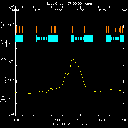A coronal mass ejection without a long-lasting X-ray event
Science Nugget: Apr 16, 1999
Introduction
The launching of a coronal mass ejection (CME) most often accompanies an
X-ray "long decay event" (LDE) or a giant arcade. These are soft X-ray
signatures of a system of large loops forming in the corona under (or near)
the location of the mass ejection, and provide some of the strongest evidence
for the occurrence of large-scale magnetic reconnection as a part of the
process of eruption. The association between CMEs and LDEs is in fact a
strong one, but a recent preprint by Davina Innes (submitted to Solar Physics)
calls attention to SOHO observations of an impulsive flare association,
to wit April 9, 1997. So, this science nugget goes back to look at this
relatively unusual event. Note that it happened just a couple of days after
the much-celebrated sigmoid ->
dimming event of April 7. The Innes et al. preprint stresses that many
of the instruments on SOHO, including CDS, made relevant observations,
so that fact (as well as its lack of an LDE) make it interesting.
What does SXT see?
In this wonderful time, we are ``calibrating'' the coronal mass ejections
- thanks to Yohkoh,
SOHO/EIT,
and now TRACE, we can see
the low corona much more clearly than we could before. In fact, with only
a coronagraph (which observes explicitly far above the solar limb) one
could never have been sure before about CME antecedents (see, for example,
the review of ``dimming'' by Hudson
and Webb).
| The GOES plot shows the impulsiveness of the event (here the colored
marks show the SXT image times, with dotted lines showing orbit night intervals: |
 |
Too bad, Yohkoh missed the beginning of the event, but that happens
a lot in our kind of orbit. The brevity of the event (ie, it's not an LDE)
is striking. The flare is a C1.5 event in ordinary active region 8026,
well-observed by Yohkoh and within a few degrees of the SW limb
at the time of the CME.
 |
Difference image spanning 3 hours before and after the event (13:50
minus 10:54 UT), showing subtle dimming and prominent flare loops in the
C1 void region found by Innes et al. |
The difference image above shows clearly that the post-event structure
has a multiple loop structure with a bright crown, typical of the loop
arcade often seen in a long-decay (LDE) event. Further large-scale brightening
above these loops suggests still larger arcade structures. The 3-hour span
of this difference implies that the arcade, though faint, persisted for
that duration. So! With a different definition of the somewhat elusive
``LDE'' terminology, one could argue that this CME too involved an LDE.
Perhaps the small angular span of the mass ejection - 27 degrees according
to the authoritative LASCO
observations, corresponds to a relatively feeble LDE arcade.
Jets or legs or ablation or streamers?
Another interesting aspect of this event has to do with jet-like structures
visible in the soft X-ray images; these are important because one passes
through the CDS
spectrometer field of view, so that Doppler imaging could be analyzed
by Innes et al. There are multiple possible interpretations of such
structures. In the classical sense of an X-ray
jet, as the magnetic leg of fieldlines opened by a CME, as the upward
evaporative flow into an arcade loop, or possibly as a helmet-streamer
geometry
Any of these scenarios seem possible at present, but we are planning
a joint observing campaign emphasizing Yohkoh
and the SUMER
EUV instrument on SOHO, in hopes of catching this sort of flare-associated
jet event with still more observational power. The observing campaign will
take place in about two weeks, so please stay tuned in case we catch something
interesting.
A modest conclusion!
The lack of a long-decay soft X-ray event observable by GOES probably says
that this coronal mass ejection was a modest one, and does not by itself
rule out the idea that all CMEs must have LDEs. On the other hand, the
narrow angular range (high collimation) of this CME still offers a puzzle,
and it would be very premature for us to imagine that we have any clear
theoretical idea here (for example, how can a narrow column of open field
lines persist and not reconnect immediately?). As for the jet-like structures,
these may provide important clues, which is why we are trying to sharpen
up our observations next month.
April 19, 1999: Hugh Hudson and Masumi Shimojo (hudson@isass0.solar.isas.ac.jp,
shimojo@flare2.solar.isas.ac.jp)


